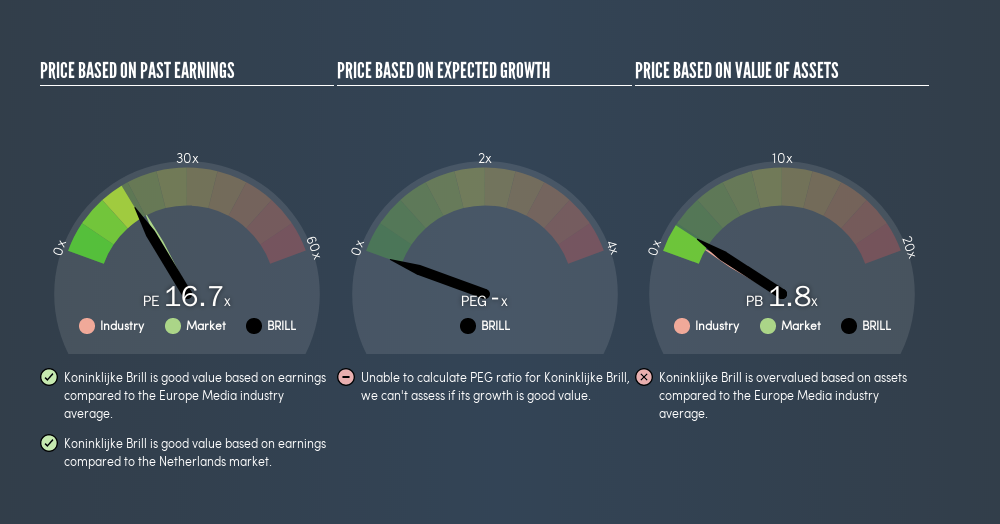- Netherlands
- /
- Media
- /
- ENXTAM:BRILL
Read This Before You Buy Koninklijke Brill NV (AMS:BRILL) Because Of Its P/E Ratio

The goal of this article is to teach you how to use price to earnings ratios (P/E ratios). We'll show how you can use Koninklijke Brill NV's (AMS:BRILL) P/E ratio to inform your assessment of the investment opportunity. Based on the last twelve months, Koninklijke Brill's P/E ratio is 16.68. In other words, at today's prices, investors are paying €16.68 for every €1 in prior year profit.
See our latest analysis for Koninklijke Brill
How Do I Calculate A Price To Earnings Ratio?
The formula for price to earnings is:
Price to Earnings Ratio = Share Price ÷ Earnings per Share (EPS)
Or for Koninklijke Brill:
P/E of 16.68 = €20.5 ÷ €1.23 (Based on the year to December 2018.)
Is A High Price-to-Earnings Ratio Good?
A higher P/E ratio implies that investors pay a higher price for the earning power of the business. That is not a good or a bad thing per se, but a high P/E does imply buyers are optimistic about the future.
Does Koninklijke Brill Have A Relatively High Or Low P/E For Its Industry?
One good way to get a quick read on what market participants expect of a company is to look at its P/E ratio. The image below shows that Koninklijke Brill has a P/E ratio that is roughly in line with the media industry average (16.9).

Koninklijke Brill's P/E tells us that market participants think its prospects are roughly in line with its industry.
How Growth Rates Impact P/E Ratios
Companies that shrink earnings per share quickly will rapidly decrease the 'E' in the equation. That means unless the share price falls, the P/E will increase in a few years. So while a stock may look cheap based on past earnings, it could be expensive based on future earnings.
Koninklijke Brill's earnings per share were pretty steady over the last year. And EPS is down 1.3% a year, over the last 5 years. So we might expect a relatively low P/E.
Remember: P/E Ratios Don't Consider The Balance Sheet
The 'Price' in P/E reflects the market capitalization of the company. That means it doesn't take debt or cash into account. Theoretically, a business can improve its earnings (and produce a lower P/E in the future) by investing in growth. That means taking on debt (or spending its cash).
Such expenditure might be good or bad, in the long term, but the point here is that the balance sheet is not reflected by this ratio.
Is Debt Impacting Koninklijke Brill's P/E?
Koninklijke Brill has net debt worth just 9.2% of its market capitalization. So it doesn't have as many options as it would with net cash, but its debt would not have much of an impact on its P/E ratio.
The Verdict On Koninklijke Brill's P/E Ratio
Koninklijke Brill's P/E is 16.7 which is below average (18.3) in the NL market. The company does have a little debt, and EPS is moving in the right direction. The P/E ratio implies the market is cautious about longer term prospects.
Investors have an opportunity when market expectations about a stock are wrong. If the reality for a company is not as bad as the P/E ratio indicates, then the share price should increase as the market realizes this. We don't have analyst forecasts, but shareholders might want to examine this detailed historical graph of earnings, revenue and cash flow.
You might be able to find a better buy than Koninklijke Brill. If you want a selection of possible winners, check out this free list of interesting companies that trade on a P/E below 20 (but have proven they can grow earnings).
We aim to bring you long-term focused research analysis driven by fundamental data. Note that our analysis may not factor in the latest price-sensitive company announcements or qualitative material.
If you spot an error that warrants correction, please contact the editor at editorial-team@simplywallst.com. This article by Simply Wall St is general in nature. It does not constitute a recommendation to buy or sell any stock, and does not take account of your objectives, or your financial situation. Simply Wall St has no position in the stocks mentioned. Thank you for reading.
About ENXTAM:BRILL
Koninklijke Brill
Operates as a publishing house in Western Europe, North America, the Asia Pacific, and internationally.
Mediocre balance sheet with weak fundamentals.
Market Insights
Community Narratives



